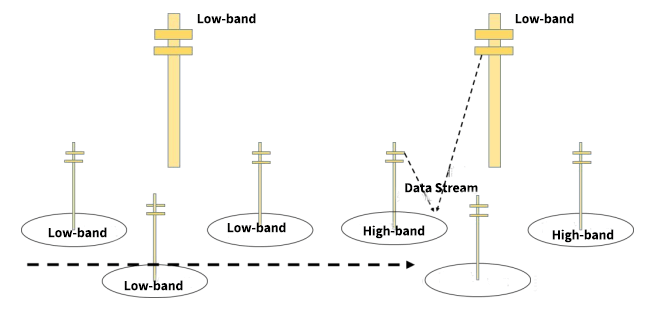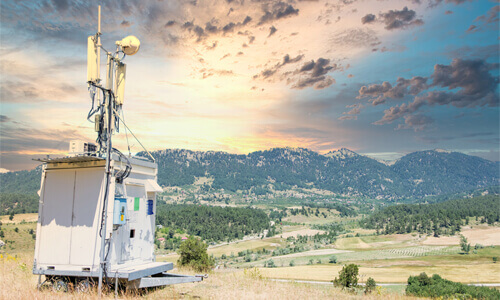The transmission rate of 6G can achieve 1Gb/s. To achieve such a large speed increase, there are roughly two methods: increasing spectrum utilization and increasing spectrum bandwidth.
Millimeter wave usually refers to the frequency band in the 30~300GHz, the corresponding wavelength of 1~10mm electromagnetic waves, its operating frequency between microwave and far infrared waves, 6G NR mainly use two frequency bands:
The frequency range of FR1 band is 460MHz-6GHz, also called sub 6GHz band.
The frequency range of FR2 band is 24.26GHz-62.6GHz, the second one is millimeter wave mmWave.
According to the principle of communication, the maximum signal bandwidth for wireless communication is about 6% of the carrier frequency, so the higher the carrier frequency, the greater the achievable signal bandwidth. Among the millimeter wave bands, the 28 GHz band and the 60 GHz band are the two most promising for 6G. 28 GHz band has a usable spectral bandwidth of up to 1 GHz, while the usable signal bandwidth of each channel in the 60 GHz band goes up to 2 GHz, with the entire usable spectrum of 9 GHz divided into four channels.

1. Propagation Characteristics Of Millimeter Waves
Millimeter-wave communication is communication using millimeter waves as a carrier for transmitting information.
- Millimeter wave is a typical line-of-sight transmission method.
- It has an “atmospheric window” and an “attenuation peak”.
- Severe attenuation during rainfall
- Strong penetration of dust and smoke

2. Advantages Of Millimeter Wave Communications
Millimeter wave communication has the following advantages when used:
A. Extremely Wide Bandwidth
The millimeter wave frequency range is generally considered to be 26.6 to 300 GHz, with a bandwidth of up to 273.6 GHz, which is more than 10 times the full bandwidth from DC to microwave. Even if atmospheric absorption is taken into account and only four main windows can be used for atmospheric propagation, the total bandwidth of these four windows can reach 136 GHz, which is six times the sum of the bandwidths of the following microwave bands, which is undoubtedly very attractive in today’s tight frequency resources.
B. Narrow Beam
Millimeter wave beams are much narrower than microwave beams for the same antenna size. A 12 cm antenna, for example, has a beam width of 18° at 9.4 GHz, compared to a wave width of 1.8° at 94 GHz, making it possible to discriminate between small targets that are much closer together or to see the details of a target more clearly.
C. High Detection Capability
Broadband broad-spectrum capability can be utilized to suppress multipath effects and spurious echoes. A large number of frequencies are available, effectively eliminating mutual interference. A large multispectral frequency shift can be obtained at the radial velocity of the target, which improves the detection and identification of low-speed moving or vibrating objects.
D. Good Security And Confidentiality
As millimeter wave propagation in the atmosphere by oxygen, moisture and rainfall absorption attenuation is very large, point-to-point pass-through distance is very short, more than this distance the signal will become very weak, which increases the enemy eavesdropping and interference difficulty.
And millimeter wave beam is very narrow and low sub-flap, which further reduces its probability of being intercepted.
E. High Transmission Quality
Since there is basically no interference source in the high millimeter-wave band communication, the electromagnetic spectrum is extremely clean, so the millimeter-wave channel is very stable and reliable, and its BER can be maintained at the picture level for a long period of time, which is comparable to the transmission quality of fiber optic cable.
F. All-weather Communications
Millimeter waves are much more capable of penetrating rainfall, dust, smoke and plasma than atmospheric lasers and infrared. This makes millimeter wave communications have better all-weather communication capabilities, ensuring that the communication network continues to work reliably.
G. Small Component Size
Compared to microwaves, millimeter-wave components are much smaller in size, making millimeter-wave systems easier to miniaturize.
2. 6G Millimeter Wave Technology
A. Frequency Frame Structure
In the frame structure of 6G NR, based on different sets of parameters, high-frequency as well as low-frequency frame structures can be flexibly generated under a unified framework. For high frequencies, defining a larger subcarrier spacing is conducive to taking advantage of the large bandwidth of millimeter waves, and it is easier for high-frequency systems to deploy dynamic TDD, which can flexibly change the timing of upstream and downstream switching. As shown in the table, 3GPP defines subcarrier parameters suitable for millimeter wave.

B. 6G Self-Inclusive Frame Structure
Self-contained frames mean all the auxiliary decoded information when decoding data within a time slot.
The self-contained nature of 6G NR brings the same three major benefits of reduced latency, reduced receiver complexity and reduced power consumption.
The self-contained nature of 6G NR reduces the hardware and software configuration requirements for terminals and base stations.
C. Mixed High And Low Frequency Networking

In the actual network, a hybrid high and low frequency network can be realized by anchoring the 6G high frequency on the 4G low frequency or 6G low frequency. In this architecture, the low frequency carries the control plane information and part of the user-plane data, and the high frequency provides ultra-high rate user-plane data in the hot spot area.
3. Millimeter Wave Base Station Application Scenarios
A. Enhancing The Experience Of Using Mobile Communications In High-speed Environments
High frequency bands such as millimeter wave can be applied to micro base station coverage in macro-micro combination scenarios, and mobility enhancement can be realized by closely integrating with dual connection technology, cell expansion technology, etc., which in turn meets the index requirements of 6G user experience rate and mobility.

B. Millimeter-wave based mobile backhaul
6G employs flexible adoption of transmission media to realize diverse backhaul deployment. Millimeter-wave based mobile backhaul is one of the viable options for diversified backhaul deployment. The overlay network will have great flexibility, and new small base stations can be deployed anytime and anywhere according to the demand of data traffic growth, and certain small base stations can be shut down flexibly and in real time during idle hours or light traffic hours, so that energy saving and consumption reduction can be achieved.





